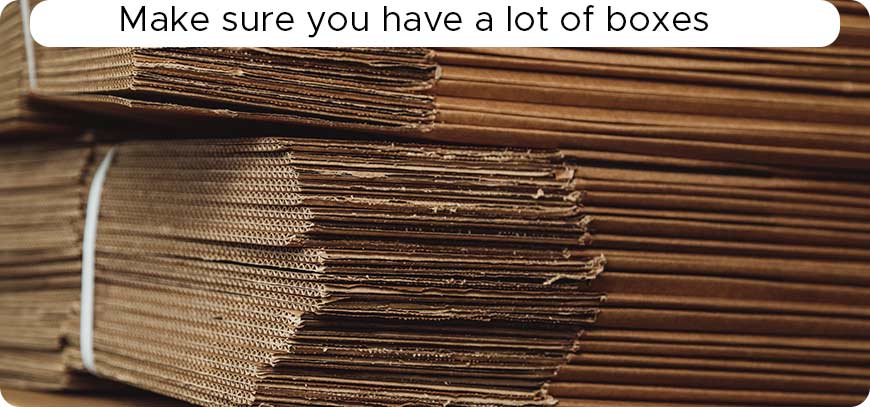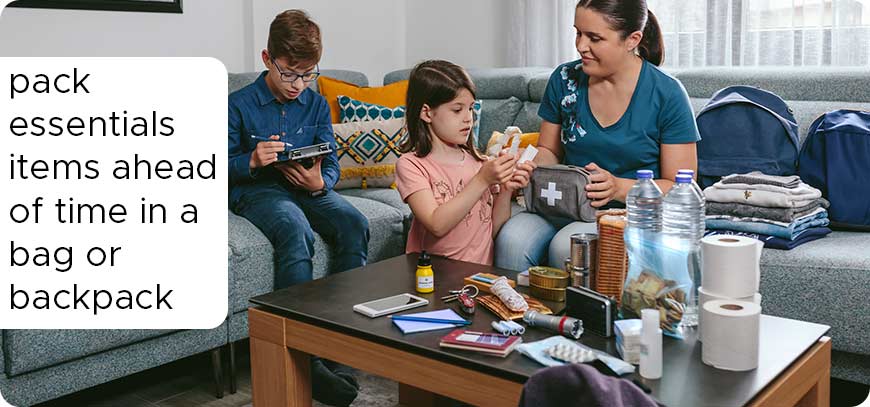How To Pack For a Move
Moving to a new home is an exciting adventure, a chance to get away from the rat race and start a new life. But it’s also one of the most stressful experiences you can have.
Packing up all your belongings and then finding and unpacking them once again in your new digs is exhausting, both physically and emotionally.
Fortunately, there are a few helpful workarounds to make this adventure more rewarding and less strenuous.
Here’s a list of tips and tricks to pack for that big move without hurting your body or losing your mind.
Organize Belongings Ahead of Time
It’s a good idea to get started with this step as soon as you know you’re going to move; giving yourself more time will make it less overwhelming. So before doing anything else, go through all the rooms in your house and organize all items into three categories: stuff to donate, stuff to keep, and stuff to throw out.
Begin with the rooms you use the least, such as the attic or the garage, and gradually work your way up to more high-traffic rooms like the kitchen. This will make the move much simpler, since you’ll only be taking items that you need. After all, there’s no sense in carrying items with you to the new home only to throw them out later.
When preparing to pack, it’s a good idea to create an inventory of items for each room. Consider color-coding each room and labeling items with the appropriate color. This will make it easy to figure out where each box should go once you’ve arrived.
Another tip: as tempting as it is, try not to get too bogged down in nostalgia as you’re sifting through these items, since this can be a major time suck. This isn’t the time for keeping memories alive; there will be time enough for that later.
Get Rid of Unwanted Items
It’s time to get real about how many of your belongings you really need to take with you. Start with your closet. Are there any clothing items which you haven’t worn for over a year? Anything that’s out of style, or no longer fits? Toss it or donate it.
When it comes to other belongings in your home, ask yourself how much you value it. Would you spend money to buy that same item now if you didn’t already have it? If the answer is no, it’s time to get rid of it.
If you need to purge large items like furniture or rugs, contact a local charity organization and find out if they will come and pick it up. Many organizations do this, and it’s a great way to save you time and aggravation as your moving date gets closer.
Finally, for those items that you don’t use a lot yet still can’t bring yourself to part with, consider placing them in a storage unit so you can decide what to do with them later.

Hire Professional Movers
Seek recommendations from friends, family members, and other people like you who have moved in the last few years to find a reliable moving company. You might also check out reviews online.
One of the perks of hiring a good moving company is that they can help you troubleshoot problems more easily. Moving is a huge project, and no matter how carefully you’ve planned it, it’s very common to find that you’ve forgotten to do something important once moving day rolls around.
Professional movers have seen it all before, and they can navigate these last-minute emergencies with the calm practicality which you need during such a stressful time. In a pinch, they can even pack things for you that you ran out of time to get to. While this will add to your bill, you’ll probably find it’s worth it.
Best of all, a moving company can save you from hurting yourself or throwing your back out with lifting heavy objects, a benefit you just can’t put a price on.
Gather Needed Materials
Save time and stress by gathering up all the packing materials you’ll need ahead of time. Be precise in taking stock of your belongings and make sure you get enough of everything so you don’t find yourself making a last-minute run to the store in the middle of the move.
One thing you’re sure to need a lot of: boxes. Fortunately, by planning ahead a little, you can find plenty of free boxes at local retail stores. Another option is to use the site Next Door Neighbor to locate used boxes. And of course, reach out to family and friends who might have some boxes on hand. Make sure you have a good mix of sizes and that every box you collect is in good condition. The last thing you need is for the bottom to fall out in the middle of moving your favorite books.
Another essential supply is bubble wrap which has been used for generations to protect items from breakage.

Rent a Dolly
Lugging one big box after another all day long is going to get old fast. Besides the sheer monotony and exhaustion, it greatly increases the chance of cherished belongings getting dropped or damaged. A better option is to rent a dolly for the day. This way, you can stack heavy boxes together and simply wheel them from one location to another. They work very well for small pieces of furniture, too. It’s sure to speed up the process, and your back will certainly thank you.
You can rent dollies from most moving companies or home improvement stores. There are several types to choose from. A utility dolly, which can typically hold up to 600 pounds, is good for smaller items; an appliance dolly is best for moving the washer, dryer, refrigerator, and/or stove. And for moving any size furniture, a furniture dolly can be your best friend.
Pack a Bag of Essentials First
Save all family members from losing their sanity by packing a bag of essentials ahead of time in a small suitcase or a duffel bag. Include any items you might need on the first day of the move before you’ve had time to unpack. Medications, clean clothing, chargers, and any necessary paperwork (i.e., birth certificates, etc.) are great things to include.
You can even take this a step further and pack an individual suitcase for each family member with items they’ll want or need right away. Unpacking and locating all your belongings after a move can take days, even weeks. Everyone will feel much better if they know they can easily access their toothbrush, toothpaste, and other toiletries.

In addition, including a few sentimental comfort items, like favorite stuffed animals or blankets, can make the move feel less chaotic. You can ask one family member to pack a suitcase with the entire family’s supply of shampoo, conditioner, and body wash to make life more comfortable while in transit. After all, the most important thing is going back to basics and having each other.
Put Plastic Around Items That Might Spill
There are few moving mishaps more upsetting than finding a bottle of shampoo or kitchen spices has spilled all over your belongings during transit. You can prevent this disaster by simply putting plastic wrap around any items that could spill such as shampoo, soap, and cleaning supplies or anything else that could cause damage to your belongings. Consider purchasing a large supply of bubble wrap cheaply from an office supply store, or for free on a website like Facebook Marketplace.
Of course, the best way to minimize the risk of spillage while moving is doing your best to use up or empty out any liquids before the moving day. Generally, the fewer liquids you have to move, the better.
Another great use for plastic wrap: wrap it around rugs or large items of furniture to condense and hold them together so they don’t take up too much space in the moving van. You can even wrap it around a chest of drawers to hold them in place. It also works great on artwork, desks, and sofas with cushions.
While it’s true that plastic wrap can be clingy and annoying, it works really well. For best results, have someone hold the object still while you do the wrapping.
Keep Formal Clothing On Hangers
While most clothing can simply be folded and placed in a box without mishap, another solution is needed for formal clothing like dresses or suits. For these, it may be worth it to purchase wardrobe boxes. These are tall containers with hanging racks across the tops which protect your fancy clothes from wrinkles and dust.
You may want to do the same thing with any clothing made from natural or cotton material which can wrinkle easily; this will save you from having to do a lot of ironing after the move. All you have to do is take them out of the wardrobe boxes and they’ll be ready to wear right away. While wardrobe boxes are not the cheapest way to solve the problem, they save you the time and expense of ironing and dry cleaning later.
Pack Items By Room
Designate specific boxes for each room, and only pack items from that room in those boxes. Clearly label each box and keep them placed close to other boxes for that room if possible. This way, when it’s time to unpack, you can quickly locate the items needed in each individual room. Remember you do not have to fill up every box.
Resist the temptation to throw your summer sandals in with your kitchen appliances, even if it seems like there’s space for them. This will avoid a lot of frustration when it’s time to unpack. One exception: packing towels or blankets with breakable items like framed photographs or electronics can help to protect them.

Use Suitcases
Suitcases make excellent packing containers because they have wheels allowing easy movement from one place to another. So don’t be afraid to pack your suitcases as full as you can with some of your heaviest items. They are much sturdier than cardboard boxes for things like books or serving dishes. And of course, as mentioned earlier, suitcases are handy for packing those few essential items that you may need during or immediately after the move.
Before packing your suitcases, check that they’re in great condition. Be wary of rips or broken zippers.
Once you know exactly how many good-quality suitcases you have, come up with a specific plan as to what items will be packed in each one.
For any soft-sided suitcases, line the inside with plastic wrap or packing paper. This will protect your belongings from the elements during the journey. And if you’re using suitcases to transport your electronics, take the extra step of wrapping these in plastic bags.
To transport clothing, roll up things like underwear, jeans or T-shirts to conserve space.
Break Down Furniture
Large furniture can be hazardous during moving. But fortunately, most furniture can be taken apart and reassembled to minimize this risk. Remove chair legs and place them in a box along with a labeled bag containing casters and nails. Couch legs can be removed, as well. Break down large dressers and cabinets so they don’t rattle around during the move. Simply removing drawers from dressers can make a big difference.
If there is a mirror on top of the dresser, dismantle and wrap it carefully in plastic wrap to transport separately. Disassembling bookshelves to transport each shelf individually minimizes the chance of scratches or other kinds of damage during the move.
Beds are among the most difficult kinds of furniture to move. In many cases, they will have to be taken apart in order to fit most moving vans. But you might be able to get away with simply removing the mattress from the bed frame and moving it that way.
Be careful to keep any nuts or bolts from disassembled furniture in a clearly labeled bag. A great strategy is to tape the bag right onto the furniture so you can find it easily.
Finally, it’s a good idea to load all furniture into the moving van first, before adding other items.
By following these simple steps, you and your family can get through moving day without injury or undue chaos.
Comments are closed.


